Rosacea, facial redness and broken capillaries are one of the most treated dermatology problems in our practice. Around 3% of population suffers from rosacea. In Melbourne Australia, where sun exposure, temperature variability and dry harsh windy weather are unpredictable, we see a lot more rosacea than elsewhere in the world.
Our specialist dermatology specialist and nursing team often combine a variety of treatment (skin care, topical prescription, oral medication and vascular laser) to treat rosacea, depending on the subtype of rosacea, skin colour type and causes.
We utilise the Gold Standard rosacea vascular laser VBEAM to reduce these changes.
Types Of Rosacea
Rosacea may be classified into many different subtypes but in reality, it is frequently overlapping in the same patient.
Traditional teachings would classify the rosacea based on appearance:
- Papulo-pustular subtype (with inflamed red papule and yellow pustules)
- Erythema-talengiectatic (redness and blood vessels)
- Rhinophymatous (fibrous changes on nose)
- Ocular (red teary eyes)
While this classification is helpful, it does not cover all aspects of rosacea. It is often more important to identify the causes of rosacea, which would then guide the most appropriate management.
These are common scenarios of rosacea we see in practice:
- Chronic sun exposure without adequate protection.
- Poor skin barrier.
- Sensitivity towards various skin products.
- Intolerability towards heat, cold; And repeated exposure to extreme temperature e.g. hot showers.
- Demodex follicularum (hair follicle mites) overgrowth.
- Unsuitable skin care products e.g. greasy emollient based products.
- Over-use of irritable skin care products.
- Over-use of unsuitable laser, peel or light devices treatments.
- Genetic familial predisposition (especially lighter skin type).
- Topical steroid use on face.
Diagnosis of Rosacea
Rosacea is generally diagnosed with clinical assessment. Experienced dermatologists or nurse practitioners will take a relevant history and perform a thorough examination. The purpose of assessment is extremely important for a number of reasons:
- Diagnose the skin condition accurately and rule out more sinister causes such as contact dermatitis, or autoimmune conditions such as lupus.
- Identify the subtypes of rosacea, which will dictate the different types of therapy.
- Identify triggers of rosacea.
- Suggest suitable range of skin care products.
- Consideration for prescription topical and oral medications (A small subset of patients may require dermatologists-only prescription oral retinoid tablets.)
- Perform pre-laser assessment, determine the need of treatment, decide treatment parameters and discuss potential realistic outcome.
There are a number of online questionnaire based assessments or special devices that are promoted to diagnose rosacea. While questionnaire based assessment can seem convenient, or devices that highlight blood vessels can seem impressive, these are never accurate methods of assessment.
MEDerm – Specialists in Rosacea Care
Rosacea is the top few conditions that MEDerm specialists and nurses treat, and we treat this almost on a daily basis!
Our treatment approach and assessment is generally holistic, and range from simple measures of correcting the wrong skin products, over the counter skin care products, prescription medications to laser therapy.
We utilise the true gold standard vascular laser Candela VBEAM device, and work closely as laser expert with the laser device company in providing the best outcome in treatment of rosacea.
Example of social media post: https://www.instagram.com/p/CMmvYUWDSKy/
While we appreciate the booking times for our specialists can be quite long, our cosmetic nursing team are well trained and can provide the initial consultation, and fast track your medical or laser treatment with our specialists if need be.
Rosacea and Red Cheeks
Rosacea, facial redness and broken capillaries are one of the most treated dermatology problems in our practice. Around 3% of population suffers from rosacea. In Melbourne Australia, where sun exposure, temperature variability and dry harsh windy weather are unpredictable, we see a lot more rosacea than elsewhere in the world.
Our specialist dermatology specialist and nursing team often combine a variety of treatment (skin care, topical prescription, oral medication and vascular laser) to treat rosacea, depending on the subtype of rosacea, skin colour type and causes.
We utilise the Gold Standard rosacea vascular laser VBEAM to reduce these changes.
Types of Rosacea
Rosacea may be classified into many different subtypes but in reality, it is frequently overlapping in the same patient.
Traditional teachings would classify the rosacea based on appearance:
- Papulo-pustular subtype (with inflamed red papule and yellow pustules)
- Erythema-talengiectatic (redness and blood vessels)
- Rhinophymatous (fibrous changes on nose)
- Ocular (red teary eyes)
While this classification is helpful, it does not cover all aspects of rosacea. It is often more important to identify the causes of rosacea, which would then guide the most appropriate management.
These are common scenarios of rosacea we see in practice:
- Chronic sun exposure without adequate protection.
- Poor skin barrier.
- Sensitivity towards various skin products.
- Intolerability towards heat, cold; And repeated exposure to extreme temperature e.g. hot showers.
- Demodex follicularum (hair follicle mites) overgrowth.
- Unsuitable skin care products e.g. greasy emollient based products.
- Over-use of irritable skin care products.
- Over-use of unsuitable laser, peel or light devices treatments.
- Genetic familial predisposition (especially lighter skin type).
- Topical steroid use on face.
Diagnosis of Rosacea
Rosacea is generally diagnosed with clinical assessment. Experienced dermatologists or nurse practitioners will take a relevant history and perform a thorough examination. The purpose of assessment is extremely important for a number of reasons:
- Diagnose the skin condition accurately and rule out more sinister causes such as contact dermatitis, or autoimmune conditions such as lupus.
- Identify the subtypes of rosacea, which will dictate the different types of therapy.
- Identify triggers of rosacea.
- Suggest suitable range of skin care products.
- Consideration for prescription topical and oral medications (A small subset of patients may require dermatologists-only prescription oral retinoid tablets.)
- Perform pre-laser assessment, determine the need of treatment, decide treatment parameters and discuss potential realistic outcome.
There are a number of online questionnaire based assessments or special devices that are promoted to diagnose rosacea. While questionnaire based assessment can seem convenient, or devices that highlight blood vessels can seem impressive, these are never accurate methods of assessment.
MEDerm – Specialists in Rosacea Care
Rosacea is the top few conditions that MEDerm specialists and nurses treat, and we treat this almost on a daily basis!
Our treatment approach and assessment is generally holistic, and range from simple measures of correcting the wrong skin products, over the counter skin care products, prescription medications to laser therapy.
We utilise the true gold standard vascular laser Candela VBEAM device, and work closely as laser expert with the laser device company in providing the best outcome in treatment of rosacea.
Example of social media post: https://www.instagram.com/p/CMmvYUWDSKy/
While we appreciate the booking times for our specialists can be quite long, our cosmetic nursing team are well trained and can provide the initial consultation, and fast track your medical or laser treatment with our specialists if need be.
Laser Therapy
Vascular Vbeam Perfecta ™ Treatment – Gold standard laser for reducing redness, capillaries, flushing and red cheeks.

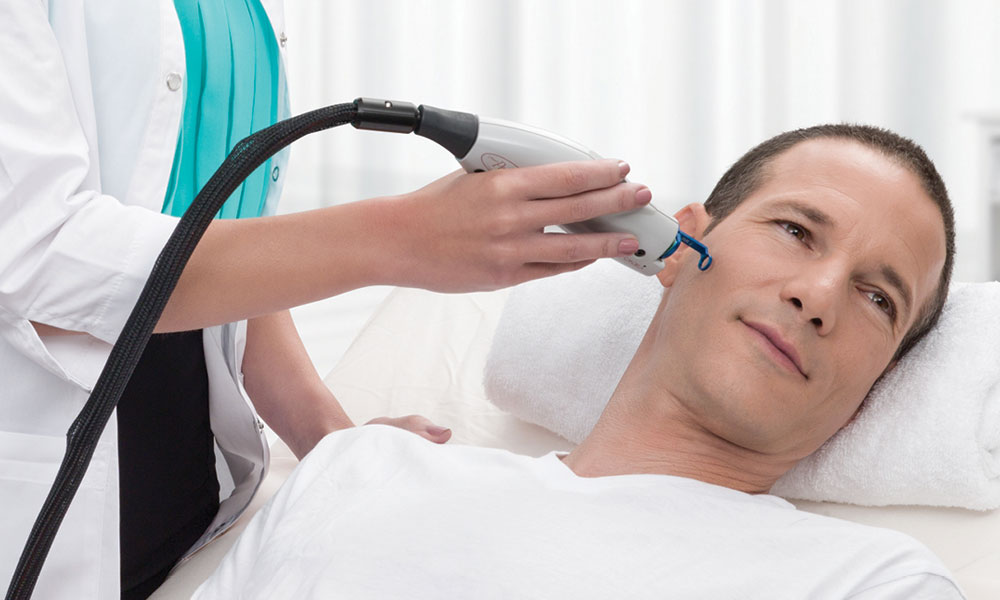
Treatment approach
Multi-modality therapy including skin care, cosmeceutical, prescription medications and vascular laser are often considered for all our patients.
Before & After
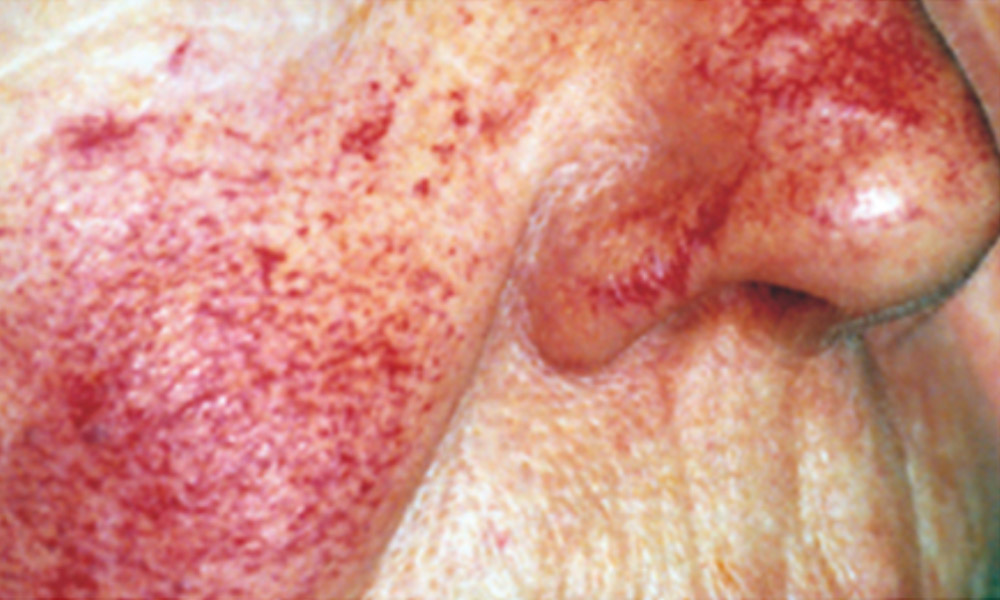
Before VBeam treatment.
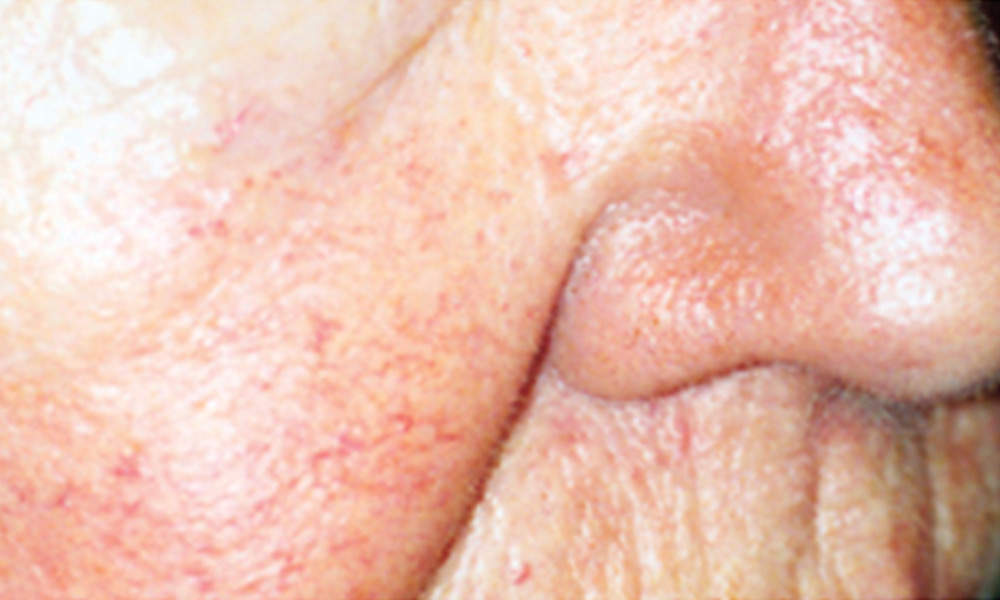
After two VBeam treatments.
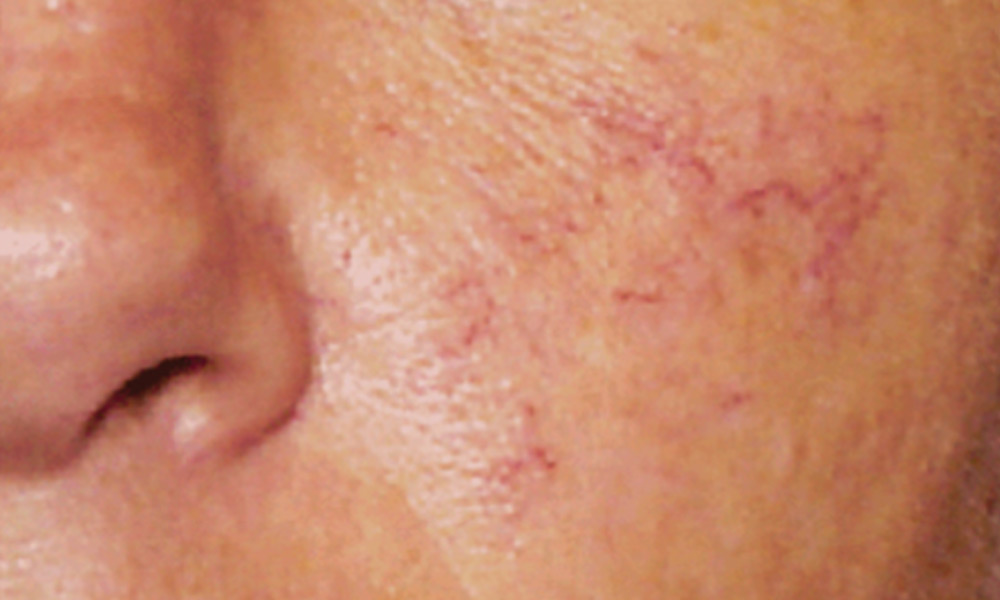
Before VBeam treatment.
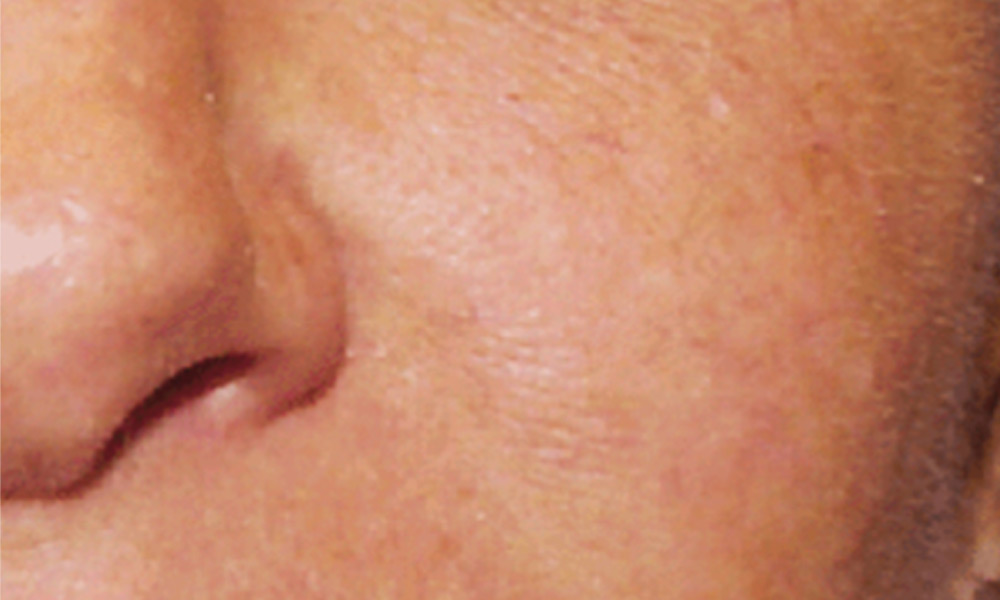
After three months treatments.
Individual results may vary. Photos by Candela
Do I have rosacea?
There are a few subtypes of rosacea. The erythemo-telangiectatic subtype can present with purely red skin, flushing and prominent capillaries (blood vessels). The papule-pustular subtype can present with just acne-like red or pus-filled lumps (hence it used to be called ‘acne rosacea’). The rhinophymatous subtype looks like lumpy fibrous enlarged nose. Some also present with irritable sore red eyes (ophthalmic rosacea).
Given this is such a common condition, the chances are you probably do have rosacea if could feel facial heat, redness, dilated vessels, with or without acne-like spots.
Can something else look like rosacea?
Yes. A number of conditions can look like rosacea. These range from common conditions such as acne to less common but serious conditions such as lupus.
Therefore it is important to be evaluated by specialist dermatologists. For example, if you have lupus but have been diagnosed as rosacea, the vascular laser may well make your conditions much worse, and you may have scarring from lupus that is not reversible if not diagnosed promptly.
Why do I have rosacea?
Nature and nurture!
Rosacea is genetically inherited in many patients. For a start, rosacea is much more common in fairer skin type. Some patients report familial tendency but it is not as simple as “if my parents don’t have it, I shouldn’t have it”. It can also affect darker skin type, which is harder to treat.
Rosacea is definitely caused or worsened by extreme temperature exposure (hot showers, sauna or hot/spicy food that brings up warmth to skin), extensive sun exposure and poor skin care.
Some rosacea are also due to topical steroid use, inappropriate greasy skin care/ make up, and there is evidence a large proportion of rosacea skin harbour hair follicle mites (Demodex follicularum) which fortunately can be treated rather easily with prescription topical medication. This can result in significant improvement within weeks of therapy.
How is rosacea treated?
Our dermatologists will perform a full assessment to ensure all aspects of treatments are covered. A variety of treatment from active cosmoceuticals (an example is topical Niacinamide), suitable light lotion sunscreen, topical prescription medication and oral medications will be used. In the recent years, we have seen good improvement on simple medications treatment that can have long lasting effects.
Redness, capillaries and flushing is best treated with vascular laser therapy. Prescription topical medicine is available, however the effect is usually short-lived (lasts hours).
Even though rosacea is a chronic condition, most rosacea patients can expect good improvement with a good comprehensive treatment plan.
What is the best laser for rosacea and capillaries?
In Melbourne Eastside Dermatology, we utilise the Candela Vbeam Perfecta™ laser. This laser has been regarded as gold standard laser for more than 10-15 years in reducing redness, flushing and broken capillaries.
The benefit of this laser is the laser energy is mainly absorbed by the “red” (Haemoglobin in blood vessels), not so much by the “brown” (Skin melanin pigmentation on the surface of skin). So this is not only the most effective laser for rosacea, it is also the safest for darker skin type.
What is the difference between Vbeam laser and IPL for rosacea?
Most large “chain” cosmetic and laser clinics would offer IPL (intenser pulsed light) treatment. IPL is not a laser, and a lot cheaper to acquire and maintain. IPL is a broad-based lamp which has a broad range of wavelength, therefore it is less specific in its treatment target. Vbeam laser no the other hand, is very specifically effective for rosacea and red skin. The easy analogy is to imagine IPL as an eraser of all colours, whereas Vbeam is an eraser of red colour. Because IPL is an eraser of all (and can injure multiple targets in skin), it is more prone to complications especially in patients of darker skin type. IPL is also likely to require multiple sessions to achieve the benefit.
In terms of other types of vascular laser, many other practices do not own/utilise Vbeam because it is more expensive to run and maintain. It is our opinion that Vbeam remains the best Gold Standard laser and therefore our treatment of choice for patients, despite the cost it would impose on our practice.
How many sessions of rosacea Vbeam laser do I require?
Even though improvement is noted right from the first treatment, we would advise first-time patients that they are likely going to require 2-3 sessions, 4-6 weeks apart. If you go with the following figures, you probably would not be too disappointed – 25-50% improvement 1st session, further 25-35% improvement in subsequent sessions. However it does vary between patients. Asian patients may expect less improvement as the laser parameter settings are set lower.
The improvement would usually last more than 12 months. Subsequently, treatment may be repeated for 1-2 sessions (usually 1 session is sufficient) every 12-24 months.
We would advise performing vascular in autumn, winter and early/mid spring. We would only suggest treatment in summer for patients of very fair skin type with no sun exposure.
Is rosacea Vbeam laser treatment painful?
Treatment is generally comfortable and not as daunting as many other lasers. For a start, it is not a “cutting” laser, so there is no bleeding. Treatment takes around 10 to 20 minutes. The full face can be treated in one session for optimal rejuvenation effect. Pain is usually tolerable, even without any anaesthesia. The equivalent level of pain is like a gentle rubber band flicking on skin, with cold spray sensation. We do not routine utilise topical anaesthesia as this could reduce result of treatment.
What happens after Vbeam rosacea laser?
After treatment, there is mild swelling and redness for usually less than 48 hours (up to 5 days). Most people would find it acceptable to go back to work on the 3rd day of treatment. Depending on the type of vessels treated, there may be a few small areas of slight bruise but this is usually avoidable.
Some facial veins and capillaries disappear almost immediately after treatment. Improvement in the redness is likely seen within a few weeks of treatment.
Is Vbeam rosacea laser safe?
We consider Vbeam to be the safest treatment laser for this indication. Majority of the side effects are the expected swelling and redness which will resolve quickly within a few days. Lightening of skin (post inflammatory hypopigmentation) and darkening of skin (post inflammatory hyperpigmentation) are rare. While any laser therapy can cause scarring, this would be considered unusual in treatment with Vbeam laser.
What is the cost for each rosacea Vbeam laser treatment?
We do not publish the cost of treatment online. Please leave a query below, or ring 98786813 to arrange a time convenient for you to discuss with our cosmetic liaison officer.
While we are a specialist practice, the costing of our laser is in line with the expertise of our doctors / nursing staff and the technology we utilise.
